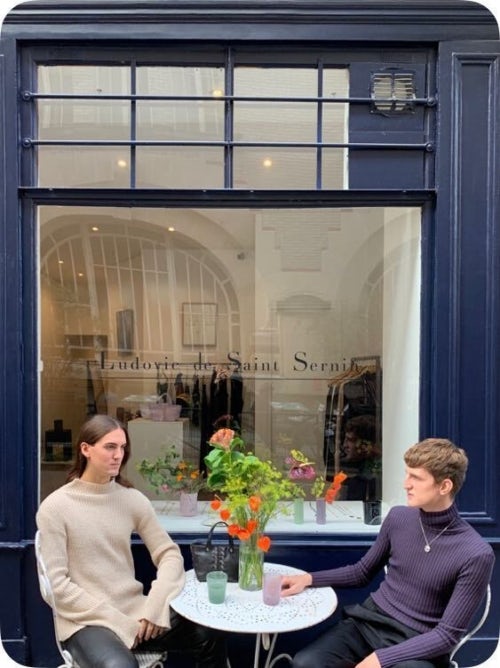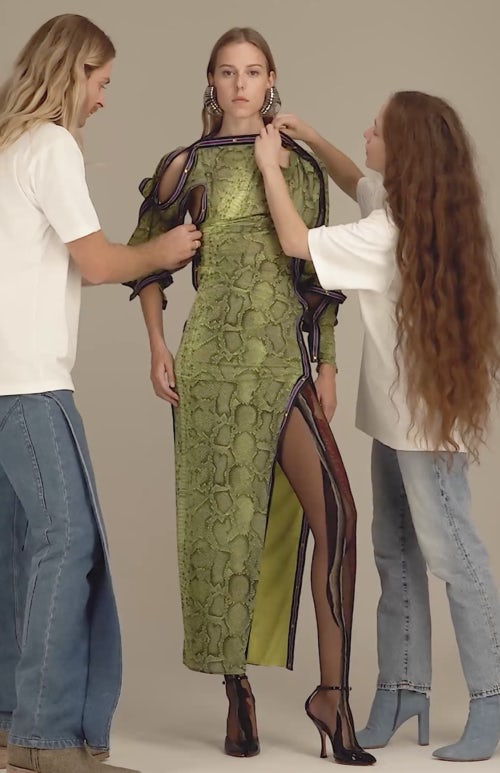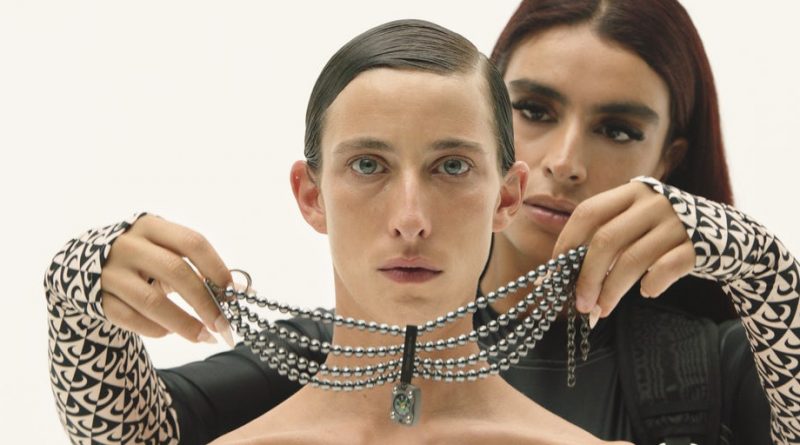How Young Designers in Paris Are Beating the Pandemic So Far | Intelligence, BoF Professional
PARIS, France — The pandemic might have buried them. So far, that hasn’t happened.
Instead, France’s emerging designers struck an optimistic tone during an unusual Paris Fashion Week, where a lighter schedule and smaller attendance reduced the pressure to invest in splashy runway activations and gave small brands more freedom to chart their own path.
In a make-or-break season, it helped that fashion-forward e-tailers like SSense were boosting orders for several young brands.
“We are still relatively small, so it’s easier to adapt,” said Marine Serre, the designer whose crescent-moon bodysuits have stormed the fashion market since she founded her label in 2017. That sentiment was echoed by the likes of Y/Project, Ludovic de Saint Sernin, Koché and Études Studio.
It’s a triumph snatched from crisis, as France’s young brands face down a pandemic that has already pushed many more established companies over the edge. Emerging designers seemed especially vulnerable, as they’ve historically depended on brick-and-mortar wholesalers to distribute their products, and tend to scrape by from season to season with little savings.
But the worst fears for creative labels have yet to materialize. Pandemic shutdowns also gave brands a chance to retool their strategies: the ones who thrived say they’re focusing on building communities online, ramping up sustainable sourcing and rethinking the way they engage with the fashion week “system.”
Their resilience stands in sharp contrast to the US market, where small creative labels like Sies Marjan folded and countless retail giants restructured through Chapter 11 bankruptcy.
It also challenges the received wisdom that bigger is always better, an understanding that’s become dogma in recent years as luxury titans LVMH and Kering vacuumed up surging demand from Chinese consumers. Prioritising owned retail over wholesale had also been lauded as a means to control image and boost margins. Now, coronavirus shutdowns and a prolonged collapse in long-haul travel have put the relevance of those retailers’ costly global store networks in question.
And while there’s no doubt that big brands’ extensive resources still give them an advantage, Paris’ nascent brands, who still count their sales in the millions (or less), benefit from far lower overheads, as well as focused branding that can pull in a loyal clientele from around the world.
“You can sustain a niche brand today. It’s not about the scale of the business, it’s about the relevance of the marketing,” said Stefano Martinetto, a fashion investor and co-founder of the distribution platform Tomorrow London. “I’m less worried about a brand that’s doing $10 million per year than one that’s doing $30 or $40 million, and which had probably been set up for 100. That’s when it gets tempting to dilute the message.”
Rethinking fashion week
With coronavirus precautions and tight finances making traditional runway shows impossible for many brands, Paris Fashion Week loosened its focus on catwalk presentations. That’s allowed emerging brands to experiment with a mix of online and offline activations, including films, low-key outdoor shows and pop-up shops, which they say alleviated budget pressure and helped them to get closer to their communities. Some of those changes are likely to stick.
In lieu of a show, Marine Serre produced a short film, “Amor Fati,” in which characters dressed in her new collection navigate a dystopian world characterized by extreme weather.
The film was lauded by runway critics as a highlight of the season: a seductive aesthetic moment whose narrative dimension exceeded what’s typically possible in a runway show. The video managed to show off her collection’s latest iteration of her signature moon logos as well as new bags, costume jewellery and eyewear, all while dodging the sense of a glorified ad campaign that dogged some larger houses’ digital fashion week outings.
“We wanted to express something of our time, as well as having a relationship to our followers a bit more directly,” Serre said. In addition to publishing the video online, she held a screening for fans at a local movie theatre and a meet-and-greet for buyers and press at the Galeries Lafayette Champs-Élysée. “I was thinking that a show where we can only be 500 people doesn’t make any sense anymore.”
Close to community
Community has also been a focus for Ludovic de Saint Sernin, a menswear designer who has cultivated a committed following for his gender-fluid knitwear and lace-up leather briefs. He’s also been rethinking the way he engages during fashion week, looking for ways to connect with clients more directly, rather than with a closed-door show.
With the ambition to expand into womenswear, he had initially hoped to stage a runway show this fall. But he ended up shooting a short film for July’s online menswear week instead after securing support from Paris Fashion Week’s organising body.

Ludovid de Saint Sernin welcomed clients and fans at a pop-up shop during fashion week. Source: Courtesy
Then for September, De Saint Sernin staged a four-day pop-up store so he could meet fans of the brand in person. “Doing it this way was a chance to be as close as possible,” he said.
The importance of that relationship is something De Saint Sernin came to appreciate amid a slew of cancelled orders and late payments during the shutdown this spring. He and his boyfriend shot images of the cancelled orders in his apartment and posted them for sale on Instagram. Orders came in from as far away as Australia, even for a few pricey made-to-measure items.
“At a time when I was worried, my community showed up and supported us,” De Saint Sernin said. Now he’s thinking more about Azzedine Alaia’s model of only showing in a runway format when it feels necessary. “I love creating and sharing imagery, and unless you have a Fendi budget, creating beautiful images from a catwalk is really hard.”
The Paris brand Études Studio is known for its “merch” aesthetic (selling EU flag hoodies and logo hats) as well as collaborations that tap the archives of artists like Keith Haring and films like Terminator 2. They’re questioning whether it ever made sense for them to stage two runway shows, on top of activations for as many as eight of those collabs each year.
“We were in a rhythm where we felt we had to always do more, more and different. It was non-stop,” said Aurélien Arbet, one of the brand’s co-founders. “It felt like you had to play that game, even for a small brand like ours, if you wanted to exist during fashion week.”
This summer the label opted for a more low-key approach, shooting a look-book and short video that didn’t garner tremendous attention in the press. Their stockists loved it though. Orders rose 20 percent over the previous year — which Arbet attributes to their more considered approach to product development and sales.
“This has been liberating and beneficial for us. Since the coronavirus crisis, we’re really finding a way to be ourselves as a brand,” Arbet said.

In a video still, stylists adjust a look from Y/Project’s SS21 collection
A critical season
To be sure, Paris’ young labels aren’t out of the woods just yet. Closing orders will be critical to their survival, as will the rebound of wholesale partners. Risks for small brands remain high during what is sure to be a lengthy and uneven recovery in the world economy.
And if the scale of big rivals like luxury groups LVMH and Kering, or smaller conglomerates like Off-White owner New Guards Group hasn’t yet pushed them off the map for consumers, they still face an uphill battle to compete with the sophistication and scale of those companies’ rapidly consolidating supply chains.
Production costs are already a pressure point: one of Marine Serre’s big wins this season was bringing down the cost of her upcycled jeans to around €800 from over €2,000 in the past. Higher costs risk alienating the communities small designers rely on, particularly in an economic downturn. They also mean that the stakes are high for selling their products at full-price, as markdowns can quickly turn into losses.
Paris’ small labels have also gotten by with help from the French government, as wage subsidies helped pay staff during months of lockdown. And injections from France’s ANDAM prize, a fund backed by the French culture and economy ministries as well as large luxury brands, also saved a couple of brands in a pinch: €200,000 ($235,180) to Marine Serre helped fund her fashion week film, while Y/Project’s Glenn Martens, a former winner, clinched a €150,000 grant.
Martens used the ANDAM money to adapt to virtual showrooming, shooting “how to wear” videos to help buyers understand the sizing and styling for his ruched and buckled knit dresses and denim (he says his best accounts like Brown’s and SSense already knew that “difficult and intriguing” pieces from his brand perform better than more commercial-looking fare, but the added guidance still helped). Some of the grant money had to be used just for production, though, as late payments hamstrung deliveries.
Moonlighting designers; larger partners
Designers are also keeping the lights on with cash injections in the form of partnerships with larger brands: proceeds from a partnership with Canada Goose helped Y/Project get through the spate of slashed and cancelled orders this spring.
And the independent designers also often have second hustles that alleviate pressure to turn a profit at their small brands. This Thursday alone, OTB-owned Diesel named Martens as its creative director, while French outerwear brand Aigle did the same for Études’ co-founders.
Koché’s designer Christelle Kocher was one of just a few young brands to stage a runway show in Paris this season — a low-key affair, with street-cast models and up-cycled looks parading through a public park. As the creative director for Chanel-owned Lemarié in addition to her brand, Kocher has signed a deal last year to delegate production and distribution for her label to OTB’s licensing unit, Staff International (She’s also won help from ANDAM in recent years, as well as a collaboration with Nike).
Freedom from investors
If these designers are willing to rethink their roles in a fashion week system, which was often fuelled by expectations of rapid growth to pay off pricey shows, that might also be because they have avoided bringing in big outside investors. Those investments can support growth and absorb losses while brands scale up, but can also encourage designers to overextend their business.
(Ami Paris may be several times bigger than Marine Serre, but the presence of a hedge fund investor keen to chase the brands’ current momentum in China may also have contributed to their choice to be Paris’ only young brand to splash out on a big runway show. They took guests out for a champagne cruise to watch a bankside catwalk on the River Seine, and later broadcast the show on a billboard in Times Square).
As for Marine Serre, the support of LVMH and ANDAM prizes and big e-commerce orders allowed her to avoid taking on big investors. Sales of her past two collections roughly doubled versus prior seasons, with annual revenue approaching €10 million euros, and she had to race to build an infrastructure to meet demand. Now she’s targeting a more moderate approach.
The 28-year-old designer says she’s trying to expand the selection of upcycled pieces in her collections (she prefers to call them “regenerated”)—a process whose sourcing constraints can stall growth—as well as targeting 100% recycled and biodegradable materials for other items.
“I don’t want to grow that much more. The important thing for us is to evolve,” Serre said. “The fact that some people were producing 10 collections per year, and selling winter clothes in summer—this moment has given us a chance to see that a lot of things were really strange.”

